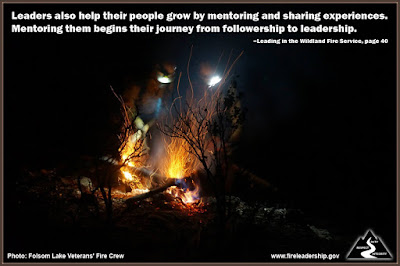On today's blog Sharon Allen-Brick, USFS Assistant Director, Workforce Development and Fire Training, shares a 5-year program management model she learned during a 1985 Professor of Women’s Studies “Women in Fire” conference at Portland State University and adapted to lead her programs.
Thank you, Sharon, for sharing your knowledge with us.
SHARON ALLEN-BRICK'S STRATEGIC 5-YEAR PLAN FOR LEADING A PROGRAM
First 12 Months
Change little unless there is a safety risk or a performance problem. Be an observer, analyzing what works and what can be improved. Develop a plan of action with targeted goals to attain/implement in the remaining 4 years.
Second 12 Months
Begin to share your mission, vision, goals with your staff and implement Phase 1 of your intended changes (minor in nature, don't push too hard).
Involve as many of your staff as you can, provide them with intent and back away (we now call it leader's intent). See if they can take your vision and make it even better. Remember it might not look exactly like what you had in mind, it may be even better. Learn to let go. Support the new ideas and creativity that will begin to develop, don't suppress input.
Reorganize if needed. Build capacity within your core staff, determine how to build a core support group that can carry the mission, vision, goals forward when you leave.
Utilize the talent of the entire workforce that you are leading. This may include Forest Fire training officers, hotshots, engine folks, chiefs, deputies, fuels, civil rights, human resources—it should be all-ranging, all-inclusive. Look for talent and develop that talent.
Third 12 Months - Move into Phase 2 of Your Intended Plan
If needed, correct and redirect the changes that are starting. The changes that are on track, leave alone—let the staff "own" the change as their own, or it will not last.
Use encouragement and praise for ideas that you like, make suggestions for the ones that you can't support—frame your input carefully. Use positive/reinforcing phrases like, "Well, what would you think about taking that and changing it here, do you think that would work?" instead of saying "No, that's not what I had in mind."
If you desire buy-in, the employees need to believe that it is also their idea and that they are contributing to the goals/vision and the ultimate end state and they have influence. Let them argue with you and don’t feel compelled to always win those arguments. They are the future, you are only facilitating that future and you do not plan to work forever.
Don’t let the naysayers who reject your ideas influence your overall goals. Don’t let the “doom and gloom” players who tell you “we’ve tried that before and it didn’t work” influence your actions. What didn’t work before may work in a new time, new organization.
“Yesterday is history, tomorrow is a mystery, today is a gift.” – Eleanor Roosevelt.Identify your replacement and begin to develop them as your shadow. If they are not a direct employee, program funds to assure they are being developed in line with where you are heading (pay for training, pay for travel, etc.). You may end up identifying multiple potential candidates as replacements. Assure that you treat them all equally.
Fourth 12 Months - Phase 3
Begin disengaging and looking for your next position. Have the staff, employees, collaborators, and visionaries develop documentation for the procedures, protocols, policy that are being implemented. Capture “best practices.”
By this point, the collaborators will have dropped what they can't support and will “own” what they do support. Reward the work that the staff and coworkers have completed. Don’t get upset about your “brilliant ideas” that the staff do not support. Don’t continue to push those ideas or attempt to persuade them to change their minds—let them go.
“Do not let your ego get so wrapped up in your job, that when your job goes your ego goes with it” – Colin Powell.Human beings are creatures of habit. Any activity that is repetitively performed over a 3-year period becomes a standard business practice out of habit and becomes ingrained as a SOP.
Assure that the initiatives/business practices that have been captured into written guides, templates, etc., are retained in a forum where all can access—website, common folders, etc.
Fifth 12 Months - Phase 4
Get ready for the move. Supervise, lead, and manage and begin to hand off responsibility. Delegate your authorities. Do not start new projects/initiatives that cannot be continued without you or they will become personality dependent. That is a waste of time, talent and treasury.
Work with management to identify a replacement from the pool that you have developed.


No comments:
Post a Comment